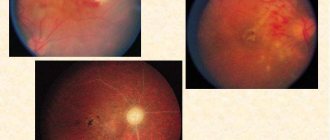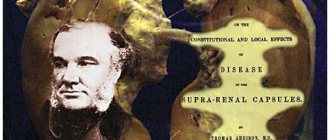Paroxysmal nocturnal hemoglobinuria (Marchiafava-Miceli disease, Strübing-Marchiafava disease)
Patients are hospitalized in the hematology department, and in case of severe anemia (below 50 g/l) - in the intensive care unit. To avoid death, specific (targeted) treatment should be started as early as possible. Patients with a subclinical form without signs of hemolysis do not need therapy; they are indicated for observation by a hematologist and regular blood tests.
Conservative therapy
Effective conservative methods that completely eliminate the manifestations of the disease are not yet available. Measures are being taken to maintain the patient’s stable condition, reduce the intensity of hemolysis, and the risk of developing life-threatening complications (thrombosis, renal failure). Conservative treatment includes the following areas:
- Targeted therapy.
The main drug that is highly effective and acts on the main link in the pathogenesis of nocturnal hemoglobinuria is eculizumab. This is a monoclonal antibody that binds to the C5 component of complement, blocking its cleavage into C5a and C5b. As a result, the formation of the membrane attack complex and proinflammatory cytokines, which cause hemolysis, destruction of neutrophils, and platelet aggregation, is inhibited. - Other methods for eliminating hemolysis.
If eculizumab is unavailable, glucocorticosteroids (prednisolone) and androgens (danazol) can be used to stop hemolysis, but their effectiveness is very low. Therefore, due to the extremely high cost of eculizumab, the main treatment for most patients remains transfusions of whole blood and its components (erythrocyte mass or suspension). Sometimes the administration of a thrombotic concentrate is required. - Symptomatic therapy.
To increase the stability of red blood cells, folic acid and vitamin B12 are prescribed; in case of severe iron deficiency, oral forms of iron supplements with ascorbic acid are prescribed, which are used with caution, since iron can provoke increased hemolysis. For the treatment and prevention of thrombosis, anticoagulants (low molecular weight heparins, warfarin) are prescribed. - Immunosuppressive therapy.
In some cases, especially when PNH is combined with aplastic anemia and myelodysplastic syndrome, cytostatics (cyclophosphamide, cyclosporine) are used to restore normal hematopoiesis. In a small number of patients, administration of antithymocyte globulin is effective.
Surgery
The only way to achieve a complete cure for the disease is stem cell allotransplantation based on the results of HLA typing to select a suitable donor. This operation is used extremely rarely, since it is associated with a large number of complications incompatible with life (graft-versus-host disease, veno-occlusive liver disease). Intervention is recommended in case of resistance to conservative methods of therapy.
Experimental treatment
Quite recently, a clinical trial of a new drug, ravulizumab, was completed. It has a similar mechanism of action to eculizumab. The main difference is a longer half-life and, therefore, a longer therapeutic effect, which allows it to be administered with less frequency than eculizumab. Currently, searches are underway for other medicinal methods of pathogenetic influence on PNH.
At a very early stage is the development of artificial anchor structures (Prodaptin), capable of restoring the expression of inhibitory proteins, in particular CD59, on the surface of blood cell membranes, which will protect them from complement. This method is more physiological, since it does not inhibit the complement system, which attacks foreign microorganisms. The new drug may be more effective and safer than complement-fixing antibodies (eculizumab, ravulizumab).
Clinical observation
Patient K
., 25 years old, was admitted to the obstetric observation department of the Moscow Regional Research Institute of Obstetrics and Gynecology on October 28, 2015 with a diagnosis of 38 weeks of pregnancy. Head presentation. Aplastic anemia in 1999, relapse in 2007, remission. Genetic thrombophilia: mutation of prothrombin F II Thr 165Met (het). Chronic viral hepatitis B without DNA replication phase. Moderate polyhydramnios. Rh negative blood (immunization at 28 weeks).
At the age of 9 years (1999), aplastic anemia was detected, one course of antithymocyte immunoglobulin was administered, during which remission was achieved. She received maintenance therapy with cyclosporine for 3 years. At the age of 17 (2007), aplastic anemia relapsed; a repeated course of antithymocyte immunoglobulin was administered with positive dynamics. Subsequently, maintenance therapy with cyclosporine was carried out for 3 years; since 2011, cyclosporine was discontinued. In 1999 and 2007, as part of the complex therapy of aplastic anemia, repeated transfusions of blood components (erythrocyte mass and platelet concentrate) were carried out.
From the obstetric history - this is the first pregnancy, the first birth is coming. At 6 weeks, inpatient treatment was carried out at the place of residence due to the threat of miscarriage and the presence of a retrochorial hematoma. At 8 weeks she was consulted by a hematologist, and it was recommended to conduct an examination to determine genetic markers of thrombophilia. The examination revealed a mutation of prothrombin F II Thr 165Met (het). Due to the high risk of thrombosis, it is recommended to start anticoagulant therapy.
From the 15th week of pregnancy, anticoagulant therapy with low molecular weight heparins (nadroparin 0.3 ml subcutaneously) was started. At 33 weeks, she was consulted by a hematologist at the Medical Research and Educational Center of Moscow State University. M.V. Lomonosov. The conclusion was given: genetic thrombophilia: mutation of prothrombin F II Thr 165Met (het). Aplastic anemia in 1999, relapse in 2007, remission. Rh (–) negative blood without sensitization symptoms. It is recommended to continue anticoagulant therapy in prophylactic doses (nadroparin 0.3 ml once a day) with cancellation one week before the expected date of delivery. For delivery, prepare 1500 ml of single-group fresh frozen plasma (FFP). In case of pathological blood loss during childbirth, perform FFP transfusions.
Throughout the entire period of pregnancy, the patient showed signs of persistent pancytopenia: the platelet level ranged from 70 to 110 thousand·109/l (before admission 70·109/l); leukocytes from 3.0-5.0·109/l, hemoglobin 90-110 g/l.
When analyzing laboratory parameters, normochromic normocytic anemia was diagnosed (erythrocytes 3.23·1012/l; Hb 99 g/l); moderate leukopenia (3.9·109/l); severe thrombocytopenia (36·109/l). Biochemical blood test: hypoproteinemia (50.9 g/l), hypoalbuminemia (25 g/l), lactate dehydrogenase (LDH) level at the upper limit of normal (245 units/l). According to thromboelastography (TEG), the density of the clot is reduced due to the platelet component.
When examining urine, the appearance of proteinuria up to 0.5 g/l and microhematuria was noted, which, when calculated using the Nechiporenko method, amounted to 2810 red blood cells in 1 ml of urine. Subsequently, there was a daily progressive increase in the level of protein and erythrocyturia up to 4.8 g/l and gross hematuria (counting impossible), respectively (Fig. 1).
Rice. 1. Dynamics of the level of hematuria (according to Nechiporenko’s method, the number of red blood cells in 1 ml of urine (a) and proteinuria (b) during the delivery of a patient with PNH. p/o - after surgery; p/o - field of view.
10/29/15 the patient was consulted by a hematologist, the diagnosis was made: relapse of aplastic anemia? Daily monitoring of platelet levels by manual Fonio counting is recommended; transfusion of platelet concentrate before and during delivery if the platelet level is less than 50·109/l.
On the same day, the patient was examined by an anesthesiologist-resuscitator. According to the American Association of Anesthesiologists (ASA), the patient's physical status was ASA III. Due to severe thrombocytopenia, regional methods of pain relief are contraindicated. During natural delivery, drug anesthesia is recommended; during cesarean section, general anesthesia with myoplegia and artificial ventilation (ALV) is recommended. Considering the high risk of bleeding and a history of repeated transfusions, it is recommended to prepare 4 doses of red blood cells washed from leukocytes and platelets (EMOLT), 6 doses of FFP, 4 doses of apheresis platelet concentrate. Considering the patient's medical history, progressive pancytopenia, and hematuria, it is recommended to screen for the presence of the PNH clone.
At this stage, it was decided to begin preparations for childbirth. With the development of regular labor, childbirth is carried out through the natural birth canal under monitor control of the intrauterine state of the fetus and contractile activity of the uterus, and the hemodynamic parameters of the woman in labor.
However, on 11/30/15 at 1:00 p.m., the patient complained of the appearance of urine intensely stained with blood with a sharp decrease in its volume. For further observation and treatment, the patient was transferred to the intensive care unit. Hemodynamic parameters are normal (BP 110/70—115/75 mm Hg, pulse 72—84 beats/min). Doppler testing of the renal vessels revealed an increase in resistance in all segments of the arterial bed of the kidneys and a decrease in velocity in the interlobar arteries on both sides. In a general urine analysis, an increase in the level of proteinuria to 4.8 g/l was noted, macrohematuria (erythrocytes covered the entire field of view, with 90% unchanged, 10% changed), the appearance of hyaline casts (2-3 in the field of view) ( see Fig. 1, 2).
Rice. 2. Dynamics of thromboelastography parameters at the stage of delivery and 2 hours after surgery. CT - clotting time; CFT - clot formation time; α—angle; MCF - maximum clot density.
The presented clinical picture, combined with data from instrumental and laboratory studies, indicated progressive acute kidney injury, which was further confirmed by an increase in the level of β2-microglobulin (β2-MG) to 2.69 mg/l as a marker of renal tubular dysfunction.
At the same time, there was an increase in the level of alkaline phosphatase (ALP), LDH, while the level of transaminases (AST, ALT) remained within normal limits (see table). We regarded an increase in LDH levels as an indirect sign of hemolysis.
Biochemical blood parameters before delivery
Taking into account the results of the clinical and laboratory examination, ex consilio
Diagnosis: 38 weeks pregnancy. Severe preeclampsia. HELLP syndrome? Aplastic anemia in 1999, relapse in 2007. It was decided to deliver the patient by caesarean section on an emergency basis. For the purpose of preoperative preparation (14:00—16:00), 500 mg of methylprednisolone and 270 ml of apheresis platelet concentrate (platelet count 1 in a dose of 3 × 1011) were administered. Diuresis during preoperative preparation (14:00—16:00) was 50 ml (0.5 ml/kg/h), gross hematuria was noted.
10.30.15 (16:10—17:10) under conditions of general anesthesia with myoplegia and mechanical ventilation, a cesarean section was performed. To induce general anesthesia, fentanyl and propofol were used in standard doses; anesthesia was maintained with a mixture of O2:N2O=50:50% with the addition of sevoflurane 1.5-2 vol% in the minimum flow mode. Intraoperative monitoring included determination of the following indicators: blood pressure, heart rate, ECG, expiratory CO2 concentration (etCO2), blood oxygen saturation (SpO2), control of acid-base status, thermometry and prevention of hypothermia. At the 10th minute, a live full-term girl weighing 3160 g, height 49 cm, without visible malformations, with an Apgar score of 8 and 9 points was extracted.
Intraoperatively, increased diffuse bleeding was observed; when performing thromboelastography (TEG) (intem + extem), severe hypocoagulation was noted, as evidenced by a significant prolongation of clot formation time (CFT); decrease in maximum clot density (MCF) as a sign of insufficient platelet function (Fig. 2). When performing the Fibtem test (determining the isolated effect of fibrinogen during the formation of clot density by blocking platelets), a deficiency of plasma coagulation factors was confirmed, which required additional administration of FFP in a volume of 900 ml, a single administration of eptacog alfa (activated) at a dose of 4.8 mg (90 µg/kg).
Intraoperative blood loss was 1000 ml (>25% of blood volume), urine output was 100 ml (2 μg/kg/h). Considering the development of severe anemia (Hb 68 g/l, Ht 21%), an EMOLT transfusion of 270 ml was performed during the operation. To correct metabolic acidosis (pH—7.29; HCO3—18.3; BE—(–)6.6; lactate—2.5 mmol/l), a 4% solution of sodium bicarbonate—200 ml—was administered. Against the background of infusion-transfusion therapy (2 hours after surgery), positive dynamics were noted in all indicators: according to TEG data, normocoagulation (see Fig. 2). The platelet level was 68·109/l, Hb - 80 g/l; CBS indicators are within normal limits.
In the postoperative period, a complete restoration of renal function was observed - through the stage of polyuria (up to 5 ml/kg/h) on the 1st day until the normalization of the diuresis rate by the 3rd day of the postoperative period. There was a significant regression of erythrocyte and proteinuria already on the 1st day p/o to 59 erythrocytes in the field of view and 0.3 g/l of protein, respectively (see Fig. 1, 2).
12 hours after surgery, low molecular weight heparins (LMWH) (nadroparin 0.3 ml s.c.) were prescribed in a prophylactic dose under the control of thrombodynamic parameters.
When determining the rate of clot formation (V, µm/min) on the 1st day of the postoperative period, hypocoagulation was recorded in the patient. The clot growth rate was consistent with the target range of therapeutic doses of LMWH. By the 4th day after surgery, against the background of a prophylactic dose of LMWH, pronounced hypercoagulation (V = 34.6 μm/min), an increase in the growth rate, size and density of the clot was obtained.
On the 4th day, we received the result of screening the patient for the presence of a PNH clone using the flow cytometry method. Immunophenotyping revealed the presence of a minor PNH clone among erythrocytes and a significant one among monocytes and granulocytes (monocytes with FLAER/CD14 deficiency - in 6.83%; granulocytes with FLAER/CD24 deficiency - in 3.67%).
On the same day, the patient complained of sharp, intense pain in the abdomen without clear localization, not associated with the surgical area, for the relief of which narcotic analgesics were required. Taking into account the presence of a significant PNH clone among monocytes and granulocytes, and the high risk of developing thrombotic complications characteristic of patients in this group, 5000 units were simultaneously administered. heparin. Taking into account thrombodynamic data, positive screening for the PNH clone, as well as the patient’s complaints, the dose of LMWH was increased 2-fold (nadroparin 0.3 ml 2 times a day subcutaneously) with an administration interval of 12 hours.
The further period proceeded without any peculiarities; antibacterial and uterotonic therapy and the administration of anti-Rhesus immunoglobulin were carried out. She was discharged in satisfactory condition on the 6th day.
Diagnostics
The diagnosis of paroxysmal nocturnal hemoglobinuria may be suspected in people who have symptoms of intravascular hemolysis (eg, hemoglobinuria, abnormally high serum LDH concentration) without a known cause. Diagnosis can be made based on a thorough clinical assessment, a detailed patient history, and various specialized tests. The main diagnostic test for people suspected of having PNH is flow cytometry, a blood test that can identify PNH cells (blood cells that lack GPI-linked proteins).
Affected Populations
PNH is thought to affect men and women in equal numbers, although some studies show a slight female predominance. The prevalence is estimated to be 0.5–1.5 per million people in the general population. The disease has been described in many racial groups and found in all regions of the world. The disorder may occur with greater frequency in people from Southeast Asia or the Far East, who are more likely to have aplastic anemia. The disorder can affect any age group. The average age of diagnosis is 30 years.
Paroxysmal nocturnal hemoglobinuria was first reported in the medical literature in the second half of the 19th century. This disorder was named paroxysmal nocturnal hemoglobinuria due to the mistaken belief that hemolysis and subsequent hemoglobinuria occur only in intermittent episodes (paroxysmal) and with greater frequency at night (at night). However, although hemoglobinuria may occur paroxysmally, hemolysis continues both day and night.









